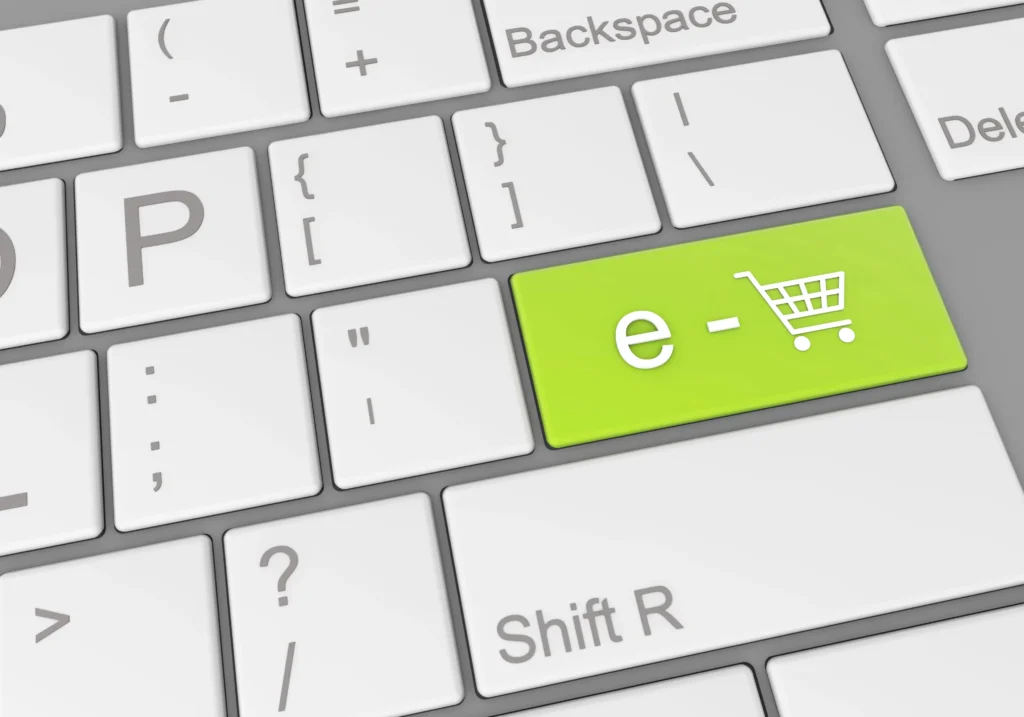In today’s dynamic world of online commerce, keeping your storefront competitive is crucial. Ecommerce migration, also known as replatforming, involves moving your existing online store to a new platform. This strategic move can unlock significant growth potential by addressing limitations of your current system and unlocking new functionalities. Whether you’re experiencing growing pains or simply want to leverage the latest features, this article by A-Dev, your trusted cloud computing management and migration partner, dives deep into the world of ecommerce migration. We’ll explore the benefits of migrating your store, the key considerations for planning a successful transition, and a step-by-step guide to navigate the process.
Ecommerce Migration Explained

Source: Freepik
What is ecommerce migration?
Ecommerce migration refers to the process of transferring your online store from its current platform to a new one. This involves migrating critical data like product information, customer details, order history, and even design elements to a fresh environment. Think of it as moving your entire store to a new location with better facilities and functionalities.
Why migrate your ecommerce store?
There are several compelling reasons why businesses choose to migrate their ecommerce stores. Here are some of the most common scenarios:
- Outgrown Existing Platform: If your current platform struggles to handle your growing product catalog, order volume, or traffic, migrating to a more robust solution can be essential for smooth operations.
- Limited Functionality: Maybe your current platform lacks features crucial for your business goals, such as advanced marketing tools, omnichannel selling capabilities, or robust content management systems.
- Security Concerns: Ecommerce platforms constantly evolve their security features. Migration can be a proactive measure to ensure your store is protected against the latest threats.
- Scalability Issues: As your business expands, your ecommerce platform needs to keep pace. Migration to a more scalable platform can ensure smooth operations during growth spurts.
- Improved User Experience: A modern platform can provide a more intuitive and user-friendly experience for your customers, leading to higher conversion rates.
Ecommerce Replatforming: Moving to a New Home

Source: Freepik
Ecommerce replatforming is another term used interchangeably with ecommerce migration. It specifically refers to the act of selecting and switching to a completely new ecommerce platform. Essentially, it’s a strategic decision to move your online store’s foundation – its core functionalities and data – to a more suitable platform that better aligns with your business needs.
Examples of Replatforming:
Imagine you’ve been running your online clothing store on a platform like Shopify for a few years. As your business grows, you might find limitations in managing a vast inventory or personalizing the customer experience. Replatforming could involve migrating your entire store to a more robust platform like Adobe Commerce (formerly Magento) that offers advanced features for product information management and customization.
Another example might be migrating from a closed-source platform with limited control to an open-source platform like WooCommerce, offering greater flexibility and customization options.
What Does Replatforming Mean in This Context?
In the context of ecommerce migration, replatforming refers to the entire process of selecting a new platform, migrating your data, and setting up your online store in the new environment. It’s a comprehensive undertaking that involves planning, execution, and post-migration adjustments.
Challenges of Replatforming
While replatforming offers significant benefits, it’s not without its challenges. Here are some key considerations:
- Complexity: Migrating a large amount of data and functionalities requires careful planning and execution. There’s a potential for errors or disruptions during the process.
- Downtime: Your online store might experience some downtime during the migration process, potentially impacting sales.
- Technical Expertise: Replatforming can involve technical complexities. You might need to hire developers or leverage migration services to ensure a smooth transition.
- Cost: Replatforming can be a significant investment, including the cost of the new platform, migration services, and potential development work.
Despite the challenges, careful planning, and partnering with experienced migration specialists can significantly mitigate these risks and ensure a successful replatforming journey. With a well-defined strategy and a focus on minimizing disruptions, replatforming can unlock significant growth potential for your ecommerce business.
Planning Your Successful Ecommerce Migration

Source:Freepik
The decision to migrate your ecommerce store to a new platform is a strategic one, paving the way for growth and improved functionality. However, a successful migration hinges on meticulous planning. Before diving headfirst into the process, it’s crucial to establish a well-defined roadmap that considers every crucial aspect of the transition.
Empower your online store for future success! Here are some key considerations to factor in as you develop your comprehensive ecommerce migration plan.
Key considerations for ecommerce migration planning
Current platform evaluation
Begin by thoroughly assessing your existing ecommerce platform. Identify its strengths and weaknesses. Understand the data formats it utilizes and any limitations associated with exporting information. This in-depth evaluation will provide a clear picture of your starting point and help guide your selection of a new platform.
New ecommerce platform selection
With a clear understanding of your current platform’s limitations and your business goals, it’s time to research and compare leading ecommerce platforms. Consider factors like scalability, feature set, pricing structure, ease of use, and security measures. Don’t be afraid to shortlist a few strong contenders and delve deeper into their functionalities before making your final decision.
Data mapping
This crucial step involves defining how data will be transferred from your old platform to the new one. Account for different data formats and ensure all critical information, such as product details, customer records, and order history, is mapped accurately. A meticulous data mapping process minimizes the risk of errors and ensures a smooth transition of your store’s core information.
Content migration strategy
Your online store’s content plays a vital role in customer engagement and brand identity. Develop a plan for migrating product descriptions, images, blog posts, and other website content. Consider the need for content updates or optimization for the new platform’s functionalities to ensure a seamless user experience.
SEO considerations
Search engine optimization (SEO) plays a vital role in driving organic traffic to your online store. Develop a plan to minimize SEO disruptions during the migration process. This may involve ensuring proper URL redirects, maintaining consistent meta descriptions, and submitting your new sitemap to search engines. By proactively addressing SEO considerations, you can minimize any potential drops in search engine ranking.
Testing and training
Rigorous testing is paramount before launching your new online store. This involves thoroughly testing all functionalities on the new platform, including checkout processes, payment gateways, search functionality, and mobile responsiveness. Additionally, ensure your staff receives proper training on using the new platform’s features and functionalities to maintain smooth operations after the migration.
Add Your Heading Text Here
By carefully considering these key factors, you can lay the foundation for a successful and efficient ecommerce migration. The next step involves charting your course with a step-by-step guide to navigate the actual migration process itself.
Charting Your Course: A Step-by-Step Guide to Migrating Your Ecommerce Store

Now that you’ve grasped the key considerations for planning your ecommerce migration, it’s time to embark on the journey itself. This step-by-step guide will equip you with a clear roadmap to navigate the migration process effectively:
Step 1: Planning and Preparation
This initial phase lays the groundwork for a smooth transition. Assemble your migration team, establish a clear timeline, and define communication channels to keep everyone informed. Additionally, take a comprehensive inventory of your existing store’s data to identify what needs to be migrated.
Step 2: Data Backup and Export
Before making any modifications, create a complete backup of your current ecommerce store’s data. This serves as a safety net in case of unforeseen circumstances. Once the backup is complete, proceed to export the necessary data according to the specifications of your new platform.
Step 3: New Platform Setup
With your chosen platform in place, it’s time to configure it to meet your specific needs. This may involve customizing settings, installing themes and plugins, and integrating with essential third-party tools for functionalities like payment processing and shipping.
Step 4: Data Import and Migration
This crucial step involves transferring your meticulously mapped data from the old platform to the new one. Ensure data integrity throughout the process to avoid errors. Some platforms offer built-in migration tools, while others may require third-party migration services.
Step 5: Content Migration
Your online store’s content plays a significant role in customer engagement. Migrate product descriptions, images, blog posts, and other website content to the new platform. Review and optimize the content to ensure it aligns seamlessly with the new platform’s functionalities and user experience.
Step 6: Testing and Refinement
Before launching your new online store, rigorous testing is essential. Test all functionalities thoroughly, including checkout processes, payment gateways, search functionality, mobile responsiveness, and overall user experience. Identify and address any bugs or inconsistencies to ensure a smooth customer experience on launch day.
Comprehensive Ecommerce Migration Checklist

Source: Freepik
This comprehensive checklist serves as a roadmap to guide you through the crucial phases of your ecommerce migration process. Utilize it alongside the step-by-step guide to ensure a smooth and successful transition to your new platform.
Planning and Preparation :
- Define project goals and objectives: Clearly outline what you aim to achieve with the migration. Is it improved scalability, enhanced functionality, or a more user-friendly experience?
- Assemble your migration team: Identify internal resources and any external specialists you might need, such as developers or a migration service provider.
- Establish a clear timeline: Develop a realistic timeline with milestones for each stage of the migration process.
- Choose a communication strategy: Determine how you’ll keep all stakeholders informed throughout the migration journey.
- Conduct a comprehensive inventory of your existing store’s data: This includes product information, customer details, order history, and website content.
- Evaluate your current ecommerce platform’s capabilities and limitations: Identify areas where your current platform is falling short and the functionalities you require in the new one.
- Research and shortlist potential new ecommerce platforms: Analyze platforms based on your business needs, considering features, scalability, security, pricing, integrations, and ease of use.
Platform Selection and Evaluation:
- Develop a selection criteria document: Outline the essential features and functionalities you require in your new platform.
- Request demos and presentations from shortlisted platforms: Gain a firsthand understanding of each platform’s capabilities and user interface.
- Evaluate factors like scalability, security, pricing structure, ease of use, and available integrations: Ensure the platform can accommodate your current and future growth needs while offering a secure environment and seamless integration with your existing tools.
- Consider the total cost of ownership: Factor in platform fees, migration costs, potential development work, and ongoing maintenance expenses.
Data Migration Strategy:
- Develop a data mapping plan: Define how data will be transferred from your old platform to the new one, ensuring accurate mapping of product information, customer details, and order history.
- Identify any data cleaning or transformation needs: Address any inconsistencies or outdated data in your existing system to ensure smooth migration and accurate information in the new platform.
- Choose a suitable data migration method: Select a method that aligns with your store’s size and complexity, such as full migration for smaller stores or phased migration for larger ones.
- Partner with a migration specialist if needed: Consider partnering with an experienced migration service provider for technical expertise and data security measures.
Security:
- Implement robust security measures throughout the migration process to safeguard sensitive customer data.
- Encrypt data during transfer and ensure secure storage on the new platform.
- Partner with a reputable migration service provider that prioritizes data security.
Legal Compliance:
- Be aware of and comply with all relevant data privacy regulations (e.g., GDPR, CCPA) when migrating customer information.
- Ensure proper customer consent for data transfer and provide clear information about how their data will be used on the new platform.
Content Migration Planning:
- Develop a strategy for migrating product descriptions, blog posts, and other website content: Evaluate existing content for relevance and identify opportunities for improvement.
- Review and update content to ensure it aligns with the new platform’s functionalities and user experience: Optimize content for the new platform’s format and consider opportunities for richer content like videos or interactive elements.
- Optimize content for search engines using relevant keywords: Maintain SEO visibility by ensuring product descriptions and website content are optimized for search engines.
- Consider creating compelling new content to enhance your brand message and attract customers: Utilize the migration as an opportunity to refresh your content strategy and create engaging content that resonates with your target audience.
Content Migration Strategy:
- Develop a content inventory to identify all website content that needs migration (product descriptions, blog posts, images, etc.).
- Audit existing content for relevance and identify opportunities for improvement or optimization for the new platform.
- Determine the best approach for migrating content (manual migration, using migration tools, etc.).
- Optimize content for search engines (SEO) to maintain organic traffic after migration.
Testing and Refinement:
- Conduct thorough testing of all functionalities on the new platform: This includes testing checkout processes, payment gateways, search functionality, mobile responsiveness, and user experience across different devices.
- Fix any bugs or inconsistencies identified during testing: Ensure a seamless user experience by addressing any technical issues found during the testing phase.
- Perform load testing to ensure the new platform can handle anticipated traffic volumes: Simulate peak traffic scenarios to guarantee your platform can handle increased customer activity without performance issues.
Launch and Go-Live:
- Develop a pre-launch marketing campaign: Generate excitement for your new online store with targeted marketing campaigns to your existing customer base and potential new audiences.
- Implement proper URL redirects: Minimize SEO disruptions by setting up proper URL redirects to ensure customers and search engines land on the correct pages on the new platform.
- Monitor key performance indicators (KPIs) after launch: Track key metrics like website traffic, conversion rates, and customer feedback to identify areas for improvement and optimize your store’s performance.
Downtime and Backup Strategy:
- Develop a strategy to minimize downtime during the migration process. This might involve phased migration or using a staging environment.
- Create a comprehensive data backup plan to ensure you can restore critical information in case of any unforeseen issues.
Post-Launch Monitoring and Optimization:
- Continuously monitor website performance and address any technical issues promptly: Proactively monitor for and address any technical issues that might arise after launch to maintain a smooth user experience. This includes monitoring website speed, error logs, and user behavior to identify and fix any problems that could hinder customer experience.
- Track SEO rankings and implement adjustments to maintain organic search visibility: Monitor your website’s search engine ranking and make necessary adjustments to content and SEO strategies to ensure optimal visibility. Use analytics tools to track organic traffic and identify any ranking drops. Analyze which keywords you’re ranking for and adjust your content strategy to target relevant keywords with high search volume.
- Analyze customer behavior and feedback to identify areas for improvement: Leverage website analytics and customer feedback surveys to understand how customers interact with your new online store. Identify areas where the user experience can be improved, such as product page optimization, checkout process streamlining, or mobile responsiveness enhancements.
- Utilize the new platform’s features to optimize marketing campaigns and enhance customer experience: Explore the marketing automation and customer engagement features offered by your new platform. These features can help you create targeted marketing campaigns, personalize the shopping experience, and improve customer retention.
Change Management:
- Develop a communication plan to keep customers and staff informed about the migration process, timelines, and any potential disruptions.
- Provide clear instructions for customers on how to navigate the new platform after launch.
- Train staff on the new platform functionalities to ensure a smooth transition.
By following this comprehensive checklist and continuously monitoring and optimizing your new ecommerce store, you can ensure a successful migration and unlock the full potential of your new platform. Remember, ecommerce is an ever-evolving landscape. Stay updated on industry trends, leverage the capabilities of your new platform, and consistently refine your strategies to keep your online store thriving.
Step 7: Website Launch and Go-Live
With everything meticulously tested and refined, it’s time to unveil your new online store to the world! Ensure proper URL redirects are in place to minimize SEO disruptions, and launch coordinated marketing efforts to generate excitement around the new platform.
Step 8: Post-Launch Monitoring
The migrating process doesn’t end with the launch. Continuously monitor your new store’s performance, track key metrics like website traffic, conversion rates, and customer feedback. This ongoing monitoring allows you to identify and address any potential issues and ensure your ecommerce store thrives in its new environment.
By following these steps and remaining vigilant throughout the process, you can successfully migrate your ecommerce store and unlock its full potential for growth and success.
The Future of Ecommerce: Embracing the Next Generation Platforms

Source: Freepik
The ecommerce landscape is constantly evolving, with innovative technologies shaping the way businesses operate and customers shop. As you navigate your ecommerce migration journey, it’s valuable to consider the trends influencing the future of ecommerce platforms:
Trends shaping the future of ecommerce platforms
The ecommerce landscape is constantly evolving, with new technologies and trends emerging that reshape how businesses operate online. As you consider an ecommerce platform migration, understanding these trends is crucial to selecting a platform that positions your store for future success. Here are some key trends that will significantly impact the future of ecommerce:
1. Headless Commerce: Tailoring the Shopping Experience
Headless commerce is a revolutionary architecture that separates the front-end presentation layer (your customers’ storefront) from the back-end functionality (data management, payment processing). This decoupling offers immense flexibility:
- Strategic Ecommerce Migration Checklist: During migration, you can leverage a headless approach to integrate best-of-breed solutions for each layer. This allows you to choose a robust back-end system that seamlessly connects with a customizable storefront, tailored perfectly to your brand identity and customer needs.
- Integrating Multiple Sales Channels: Headless commerce empowers you to integrate your online store with various sales channels (mobile apps, social media platforms) for a truly omnichannel experience. This fosters brand consistency and allows customers to seamlessly interact with your brand across different touchpoints.
2. Cloud-Based Solutions: Agility and Scalability in the Cloud
Cloud-based ecommerce platforms offer numerous advantages that can streamline your migration process and enhance your online store’s long-term operation:
- Website Migration Strategy: Cloud platforms eliminate the need for on-premise infrastructure, simplifying the website migration project. There’s no need to manage servers or software updates, freeing up your team to focus on core business activities.
- Scalability for Growth: Cloud solutions are inherently scalable, allowing your ecommerce store to adapt to growing traffic and data demands. This ensures a smooth user experience even during peak seasons or with a surge in new customers.
- Data Migration Process: Cloud platforms often offer built-in migration tools or seamless integration with third-party migration services. This can simplify data migration during your ecommerce platform migration and minimize data-related risks.
3. AI and Machine Learning: Personalization at the Forefront
Artificial intelligence (AI) and machine learning (ML) are transforming ecommerce by personalizing the shopping experience and driving sales:
- Personalized and Omnichannel Experiences: AI algorithms can analyze customer behavior data to provide targeted product recommendations, improve search functionality, and deliver personalized promotions across all channels. This fosters customer loyalty and satisfaction.
- SEO Audit Post Migration: AI-powered tools can be leveraged to conduct a comprehensive SEO audit after your migration. This helps identify areas for improvement and ensures your new ecommerce site maintains optimal search engine ranking.
- Successful Online Promotion: AI can automate marketing campaigns and create time-sensitive promotions that resonate with your target audience. This helps you attract organic traffic and boost your online sales.
4. Embracing the Future: A Checklist for Success
As you navigate your ecommerce platform migration, consider these key points to ensure you’re selecting a future-proof solution:
- Platform Supports Your Needs: Choose a platform that caters to your specific business requirements and growth projections. Ensure it offers the functionalities and integrations you need to support your current and future ecommerce operations.
- Suitable Migration Method: Select a data migration method that aligns with the size and complexity of your store’s data. Consider factors like a full migration for smaller stores or a phased migration for more extensive datasets.
- Change Management: Develop a clear communication plan to keep customers and staff informed throughout the migration process. This helps manage expectations and minimizes disruptions during the transition to the new platform.
By understanding these trends and incorporating them into your strategic ecommerce migration checklist, you can make an informed decision when selecting a new platform. This ensures a successful migration process and positions your ecommerce store for long-term success in the ever-evolving landscape of online commerce.





